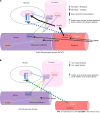Hypothesis that alpha-amylase evokes regulatory mechanisms originating in the pancreas, gut and circulation, which govern glucose/insulin homeostasis
- PMID: 37771332
- PMCID: PMC10523231
- DOI: 10.4239/wjd.v14.i9.1341
Hypothesis that alpha-amylase evokes regulatory mechanisms originating in the pancreas, gut and circulation, which govern glucose/insulin homeostasis
Abstract
The anti-incretin theory involving the abolishment of diabetes type (DT) II by some of methods used in bariatric surgery, first appeared during the early years of the XXI century and considers the existence of anti-incretin substances. However, to date no exogenous or endogenous anti-incretins have been found. Our concept of the acini-islet-acinar axis assumes that insulin intra-pancreatically stimulates alpha-amylase synthesis ("halo phenomenon") and in turn, alpha-amylase reciprocally inhibits insulin production, thus making alpha-amylase a candidate for being an anti-incretin. Additionally, gut as well as plasma alpha-amylase, of pancreatic and other origins, inhibits the appearance of dietary glucose in the blood, lowering the glucose peak after iv or oral glucose loading. This effect of alpha-amylase can be interpreted as an insulin down regulatory mechanism, possibly limiting the depletion of pancreatic beta cells and preventing their failure. Clinical observations agree with the above statements, where patients with high blood alpha-amylase concentrations are seldom obese and seldom develop DT2. Obese-DT2, as well as DT1 patients, usually develop exo-crine pancreatic insufficiency (EPI) and vice versa. Ultimately, DT2 patients develop DT1, when the pancreatic beta cells are exhausted and insulin production ceases. Studies on biliopancreatic diversion (BPD) and on BPD with duodenal switch, a type of bariatric surgery, as well as studies on EPI pigs, allow us to observe and investigate the above-mentioned phenomena of intra-pancreatic interactions.
Keywords: Acini-islet-acinar axis; Alpha-amylase; Bariatrics; Diabetes; Exocrine pancreatic insufficiency; Glucagon-like peptide-1; Glucose-dependent insulinotropic polypeptide; Hyperglycaemia; Incretins; Insulin; Pancreas; Pancreatic enzyme therapy.
©The Author(s) 2023. Published by Baishideng Publishing Group Inc. All rights reserved.
Conflict of interest statement
Conflict-of-interest statement: Authors declare no competing interests.
Figures



References
-
- Hellman B, Wallgren A, Petersson B. Cytological characteristics of the exocrine pancreatic cells with regard to their position in relation to the islets of Langerhans. A study in normal and obese-hyperglycaemic mice. Acta Endocrinol (Copenh) 1962;39:465–473. - PubMed
-
- Pierzynowski S, Barej W. The dependence of exocrine pancreatic secretion on insulin in sheep. Q J Exp Physiol. 1984;69:35–39. - PubMed
-
- Williams JA, Goldfine ID. The insulin-pancreatic acinar axis. Diabetes. 1985;34:980–986. - PubMed
-
- Pierzynowski SG, Podgurniak P, Mikołajczyk M, Szczesny W. Insulin and the parasympathetic dependence of pancreatic juice secretion in healthy and alloxan diabetic sheep. Q J Exp Physiol. 1986;71:401–407. - PubMed
Publication types
LinkOut - more resources
Full Text Sources
Other Literature Sources

